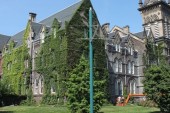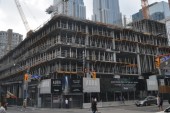
 North York has a rich legacy of modernist architecture, but this can sometimes be overlooked by members of the heritage community who prefer to focus their efforts on buildings of older vintage. We talk to Geoff Kettel, Chairperson of North York Community Preservation Panel, about the changing face of North York’s architectural landscape. Tomorrow night Kettel is a curating a forum entitled “Suburbia: Heritage of the Everyday” at the North York Civic Centre. How would you characterize North York’s architecture before the post-war boom? GEOFF KETTEL: Three main phases of post-colonial development of (pre-amalgamation) North York can be identified: the rural phase with its farms (e.g. the Stong Farmhouse at York University), industry (e.g. Milneford Mills on the Don River) and villages (e.g. Willowdale, Newtonbrook, Lansing and Fairbanks); the suburban phase of the 1950s-1980s, which is associated with the International style or “Modernist” architecture; and the renewed intensification phase of the late 20th and early 21st century with a mixture of styles and materials. What made the post-war boom in North York possible? And what were its defining elements architecturally? Massive population growth in the Township (later the City) of North York was driven by post-war immigration and family formation, and the need for homes. The form of development, however, was profoundly affected by the automobile, and the introduction of large scale planning undertaken by municipal governments and the developers of large scale subdivisions such as Don Mills. The defining elements are the large grid network of arterial roads, and the “planned” subdivisions with their curving streets and cul de sacs. The housing elements are the single family homes, the multi-family townhomes and the “towers in the park,” the large slab concrete apartment complexes built by public and private developers, often surrounded by acres of green grass. How has North York’s architecture evolved more recently, in contrast to the post-war boom? North York is today experiencing a period of renewed development, intensification and infilling. The single family suburbs are being changed almost beyond recognition by the reconstruction of homes with far greater massing and height, which often involve demolition. The apartment towers have changed demographically with much increased and diverse populations. They are frequently in need of reinvestment in major systems, and to improve energy efficiency. The city has begun to look at these issues with its Tower Renewal Project in a broad context of land use planning and their social and physical environments. Are there particular buildings in North York you point to as representative of thepost-war boom? It is fortunate that the former City of North York, prior to amalgamation of the six former municipalities in Metro Toronto in 1998, did an inventory of its Modernist buildings. The 1997 North York’s Modernist Architecture report acknowledged approximately 200 structures as Modernist Architecture Projects in the City of North York that were constructed between 1945-1981. In 2010, ERA Architects updated the inventory, and North York’s Modernist Architecture Revisited included 214 projects constructed within that time frame in the former municipality. These include a wide range of types of architecture, and architects, including Don Mills (the district), the Ontario Science Centre, the Prince Hotel and the Ross Building at York University. Is North York’s modernist architecture appreciated to the extent that it should be? Modernist architecture presents a special challenge to the heritage community; it’s often not recognized as being “vintage” architecture–primarily it’s not considered old enough, neither is it sufficiently distinct from today’s structures in terms of massing, scale and building material. The North York Modernist Architecture Forum, this year being the third year, has again as one of its goals, to raise awareness and increase public appreciation of Modernist Architecture in North York. Does anything distinguish North York from other Toronto suburbs? Of all the former boroughs/cities of Toronto, arguably the City of North York has the richest legacy of Modernist architecture. However there are many fine examples of Modernist architecture elsewhere in the Toronto, such as the Scarborough campus of the University of Toronto. What do you think the future holds for suburbs like North York? The 2010 ERA report confirmed that North York contains a rich legacy of Modernist Architecture that is deserving of protection. North York’s Modernist Architecture Revisited addressed questions such as: which properties exist in their original form today; which buildings have been extensively altered or demolished; and which properties have been listed and/or designated under the City of Toronto Inventory of Heritage Properties? The inventory determined that 67 of the original 200 projects were demolished (including Bata International and Inn on the Park) or heavily modified. Only 40 of the 215 were in the City of Toronto Inventory of Heritage Properties (“listed”). In addition, the Report acknowledges the design champions of Modernist Architecture, which hopefully will lead to greater recognition of their work. The North York Community Preservation Panel has begun the discussion of a strategy for listing and/or designation under the Ontario Heritage Act of significant North York Modernist Architecture properties that are not currently protected. “Suburbia: Heritage of the Everyday”–2011 North York Modernist Architecture Forum, moderated by Christopher Hume, Thursday, November 3, North York Civic Centre, 7 pm.
North York has a rich legacy of modernist architecture, but this can sometimes be overlooked by members of the heritage community who prefer to focus their efforts on buildings of older vintage. We talk to Geoff Kettel, Chairperson of North York Community Preservation Panel, about the changing face of North York’s architectural landscape. Tomorrow night Kettel is a curating a forum entitled “Suburbia: Heritage of the Everyday” at the North York Civic Centre. How would you characterize North York’s architecture before the post-war boom? GEOFF KETTEL: Three main phases of post-colonial development of (pre-amalgamation) North York can be identified: the rural phase with its farms (e.g. the Stong Farmhouse at York University), industry (e.g. Milneford Mills on the Don River) and villages (e.g. Willowdale, Newtonbrook, Lansing and Fairbanks); the suburban phase of the 1950s-1980s, which is associated with the International style or “Modernist” architecture; and the renewed intensification phase of the late 20th and early 21st century with a mixture of styles and materials. What made the post-war boom in North York possible? And what were its defining elements architecturally? Massive population growth in the Township (later the City) of North York was driven by post-war immigration and family formation, and the need for homes. The form of development, however, was profoundly affected by the automobile, and the introduction of large scale planning undertaken by municipal governments and the developers of large scale subdivisions such as Don Mills. The defining elements are the large grid network of arterial roads, and the “planned” subdivisions with their curving streets and cul de sacs. The housing elements are the single family homes, the multi-family townhomes and the “towers in the park,” the large slab concrete apartment complexes built by public and private developers, often surrounded by acres of green grass. How has North York’s architecture evolved more recently, in contrast to the post-war boom? North York is today experiencing a period of renewed development, intensification and infilling. The single family suburbs are being changed almost beyond recognition by the reconstruction of homes with far greater massing and height, which often involve demolition. The apartment towers have changed demographically with much increased and diverse populations. They are frequently in need of reinvestment in major systems, and to improve energy efficiency. The city has begun to look at these issues with its Tower Renewal Project in a broad context of land use planning and their social and physical environments. Are there particular buildings in North York you point to as representative of thepost-war boom? It is fortunate that the former City of North York, prior to amalgamation of the six former municipalities in Metro Toronto in 1998, did an inventory of its Modernist buildings. The 1997 North York’s Modernist Architecture report acknowledged approximately 200 structures as Modernist Architecture Projects in the City of North York that were constructed between 1945-1981. In 2010, ERA Architects updated the inventory, and North York’s Modernist Architecture Revisited included 214 projects constructed within that time frame in the former municipality. These include a wide range of types of architecture, and architects, including Don Mills (the district), the Ontario Science Centre, the Prince Hotel and the Ross Building at York University. Is North York’s modernist architecture appreciated to the extent that it should be? Modernist architecture presents a special challenge to the heritage community; it’s often not recognized as being “vintage” architecture–primarily it’s not considered old enough, neither is it sufficiently distinct from today’s structures in terms of massing, scale and building material. The North York Modernist Architecture Forum, this year being the third year, has again as one of its goals, to raise awareness and increase public appreciation of Modernist Architecture in North York. Does anything distinguish North York from other Toronto suburbs? Of all the former boroughs/cities of Toronto, arguably the City of North York has the richest legacy of Modernist architecture. However there are many fine examples of Modernist architecture elsewhere in the Toronto, such as the Scarborough campus of the University of Toronto. What do you think the future holds for suburbs like North York? The 2010 ERA report confirmed that North York contains a rich legacy of Modernist Architecture that is deserving of protection. North York’s Modernist Architecture Revisited addressed questions such as: which properties exist in their original form today; which buildings have been extensively altered or demolished; and which properties have been listed and/or designated under the City of Toronto Inventory of Heritage Properties? The inventory determined that 67 of the original 200 projects were demolished (including Bata International and Inn on the Park) or heavily modified. Only 40 of the 215 were in the City of Toronto Inventory of Heritage Properties (“listed”). In addition, the Report acknowledges the design champions of Modernist Architecture, which hopefully will lead to greater recognition of their work. The North York Community Preservation Panel has begun the discussion of a strategy for listing and/or designation under the Ontario Heritage Act of significant North York Modernist Architecture properties that are not currently protected. “Suburbia: Heritage of the Everyday”–2011 North York Modernist Architecture Forum, moderated by Christopher Hume, Thursday, November 3, North York Civic Centre, 7 pm.














